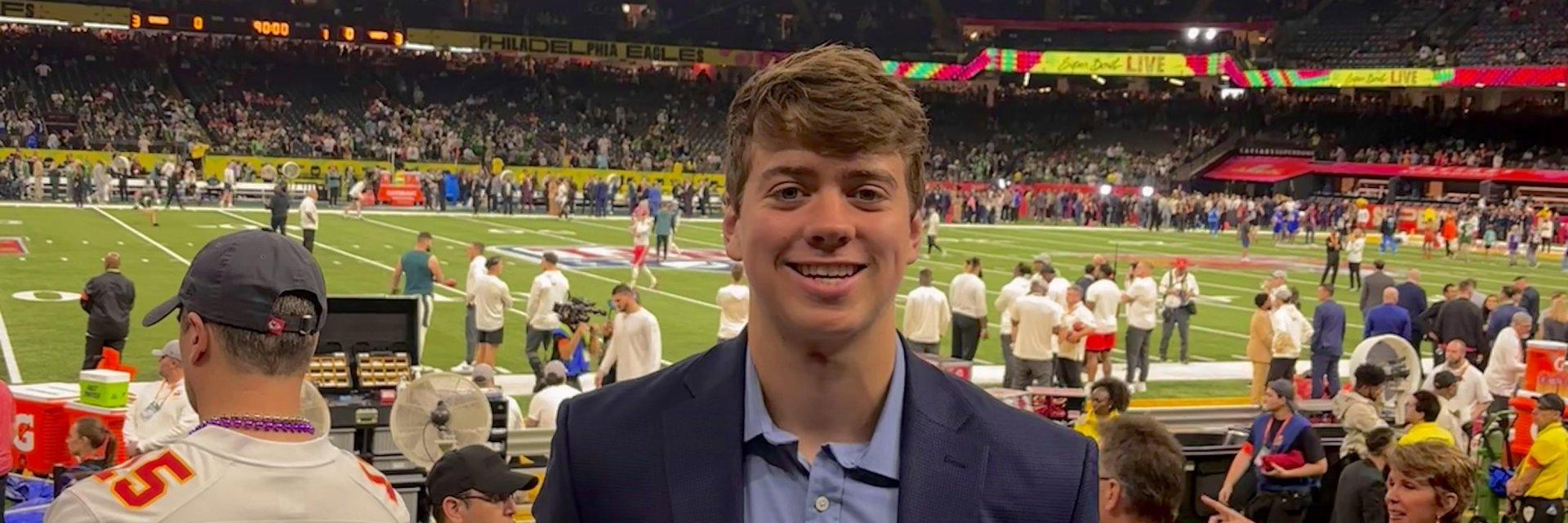Super Bowl Student Reporters
The Shirley Povich Center for Sports Journalism sends one Merrill College student to cover the Super Bowl on-site each February.
The program, which started in 2017, added a partnership with Sports Business Journal in 2022. The student is embedded in SBJ's coverage team for the week leading up to the big game, as well as reporting stories for Merrill College's Capital News Service.
- 2025: Sam Jane
- 2024: Nicky Wolcott
- 2023: Varun Shankar
- 2022: Jacob Richman
- 2021: N/A (COVID-19 pandemic)
- 2020: Ryan McFadden
- 2019: James Crabtree-Hannigan
- 2018: Kyle Melnick
- 2017: Callie Caplan
Super Bowl 59: 'Most important experience in my career so far'
Sam Jane '26
Feb. 11, 2025
Covering a Super Bowl is exhilarating, hectic, productive and exhausting. I’ve never attended an event like it. Nearly the entire sports media industry piled into New Orleans, and the city's convention center became a hub for journalists, broadcasters, athletes and businesses.
I introduced myself to NFL Network’s Tom Pelissero, The Athletic’s Dianna Russini and high-level Fox Sports executives. I had a meal with the Washington Post's Sam Fortier, who covered the Commanders surprise playoff run. The Sports Business Journal team and I enjoyed oysters over dinner.
That didn’t even include the reporting. I attended team press availabilities, Fox Sports media day, Media Row and other events. I produced seven articles for the Sports Business Journal team and two for Capital News Service.
All of those events are prior to the game. That’s what makes the Super Bowl such a large event, a spectacle before the two teams even meet on the field.
The game itself is just as impressive. I went to the NFL’s official tailgate, which meant live music, food and drinks, along with plenty of opportunities to network. (The heat was sweltering, though, meaning I had a slight sweat problem.)
Sports Business Journal’s Ben Fischer showed me around the tailgate. He pointed out different high-level executives and team officials who attended the party. We listened to the music and chatted before I headed to the Superdome around 3 pm.
I like to arrive at stadiums around two hours before the coin toss. It allows me to feel the pregame energy, watch warmups and prepare for the game.
The Super Bowl’s pregame was highly sophisticated. On my press pass, a QR code presented the press box location, steps to get there and gave me certain access at different points in the stadium. I was not allowed to step on the field, but I was able to cruise around the stadium’s general perimeter.
Once I arrived at the press box, it hit me. I was covering the Super Bowl. The SBJ team was placed in the auxiliary press box, which is usually traditional seating. Fischer said the outlet prefers that location, because it’s open air and allows you to feel the stadium’s energy. I agreed.
The Superdome provided energy from the start of the game. The Eagles completely dominated, meaning a game story was easy to write. Before the game even started, I had an idea of I wanted to write about: Kellen Moore, Philadelphia’s offensive coordinator and the future New Orleans Saints coach.
It became much easier to write about Moore when the Eagles put up 40 points. I interviewed players after the game and filed my story for Capital News Service.
The days were long in New Orleans. It was a mentally draining week at times. But there’s also no question that it’s been the most important experience in my career so far.

